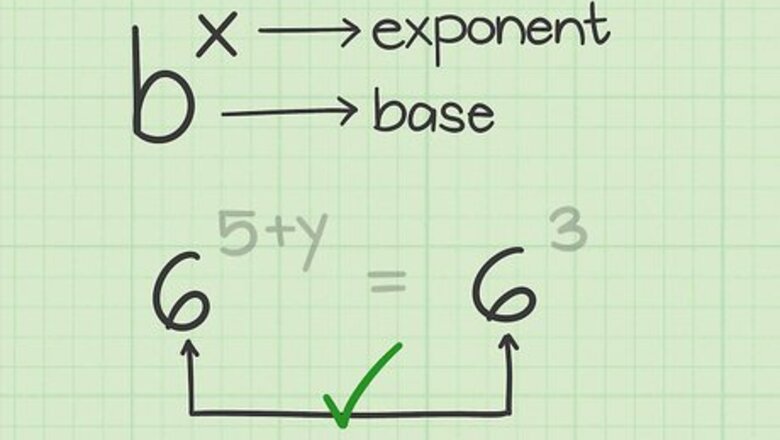
views
Equating Two Exponents with the Same Base
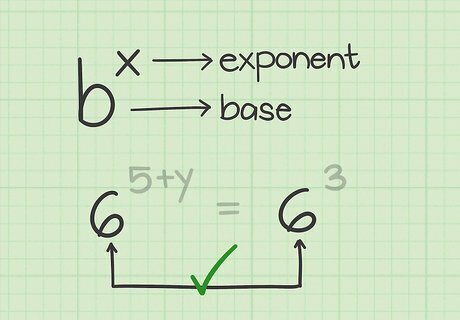
Determine whether the two exponents have the same base. The base is the big number in an exponential expression. You can only use this method when you are presented with an equation that has an exponent on either side, and each exponent has the same base. For example, 6 5 + y = 6 3 {\displaystyle 6^{5+y}=6^{3}} 6^{{5+y}}=6^{{3}} has an exponent on either side of the equation, and each exponent has the same base (6).
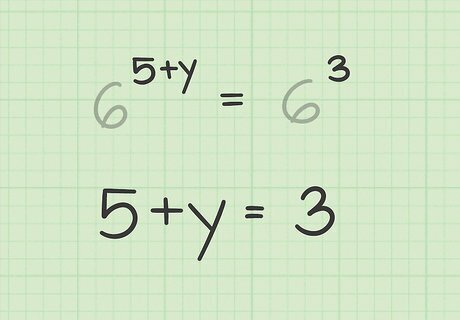
Ignore the base. Since the exponents are equal and have the same base, their exponents must be equal. As such, you can ignore the base and write an equation for the exponents only. For example, in the equation 6 5 + y = 6 3 {\displaystyle 6^{5+y}=6^{3}} 6^{{5+y}}=6^{{3}}, since both exponents have the same base, you would write an equation for the exponents: 5 + y = 3 {\displaystyle 5+y=3} 5+y=3.

Solve the equation. To do this, you need to isolate the variable. Remember that whatever you do to one side of an equation, you must do to the other side of the equation. For example: 5 + y = 3 {\displaystyle 5+y=3} 5+y=3 5 + y − 5 = 3 − 5 {\displaystyle 5+y-5=3-5} 5+y-5=3-5 y = − 2 {\displaystyle y=-2} y=-2
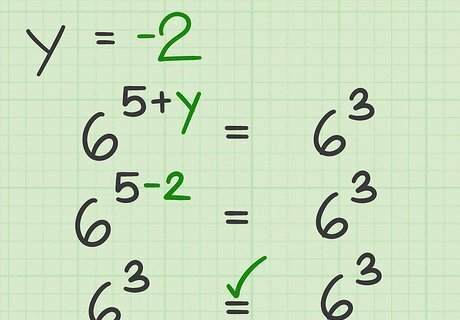
Check your work. To make sure that your answer is correct, plug the value you found for the variable back into the original equation, and simplify the expression. The two sides should be equal. For example, if you found that y = − 2 {\displaystyle y=-2} y=-2, you would substitute − 2 {\displaystyle -2} -2 for y {\displaystyle y} y in the original equation: 6 5 + y = 6 3 {\displaystyle 6^{5+y}=6^{3}} 6^{{5+y}}=6^{{3}} 6 5 − 2 = 6 3 {\displaystyle 6^{5-2}=6^{3}} 6^{{5-2}}=6^{{3}} 6 3 = 6 3 {\displaystyle 6^{3}=6^{3}} 6^{{3}}=6^{{3}}
Equating an Exponent and a Whole Number
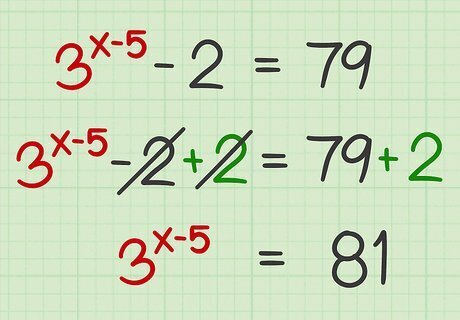
Isolate the exponential expression. Make sure that there is an exponential expression on one side of the equation, and a whole number on the other side. If not, you need to rework the equation so that the exponent is alone on one side. For example, if your are trying to solve 3 x − 5 − 2 = 79 {\displaystyle 3^{x-5}-2=79} 3^{{x-5}}-2=79, you first need to isolate 3 x − 5 {\displaystyle 3^{x-5}} 3^{{x-5}} by adding 2 to each side of the equation: 3 x − 5 − 2 = 79 {\displaystyle 3^{x-5}-2=79} 3^{{x-5}}-2=79 3 x − 5 − 2 + 2 = 79 + 2 {\displaystyle 3^{x-5}-2+2=79+2} 3^{{x-5}}-2+2=79+2 3 x − 5 = 81 {\displaystyle 3^{x-5}=81} 3^{{x-5}}=81

Rewrite the equation. You need to determine whether the whole number can be converted to an exponent with the same base as the other exponent. If you can’t convert the whole number in this way, you cannot use this method. For example, look at the equation 3 x − 5 = 81 {\displaystyle 3^{x-5}=81} 3^{{x-5}}=81. You need to change 81 to an exponent with a base of 3, so that it matches the other exponential expression in the equation. By factoring out 3, you should see that 3 × 3 × 3 × 3 = 81 {\displaystyle 3\times 3\times 3\times 3=81} 3\times 3\times 3\times 3=81, so 3 4 = 81 {\displaystyle 3^{4}=81} 3^{{4}}=81. The new equation then becomes 3 x − 5 = 3 4 {\displaystyle 3^{x-5}=3^{4}} 3^{{x-5}}=3^{{4}}.
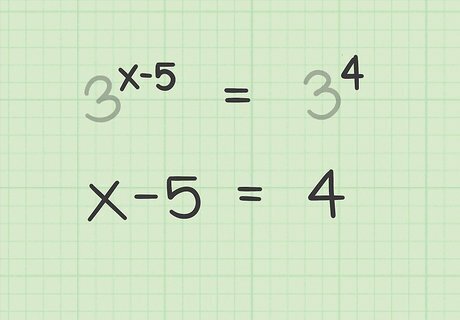
Write the equation for the exponents only. Since you converted the whole number, you now have two exponential expressions with the same base. Since the bases are the same, you can ignore them and focus on the exponents. For example, since 3 x − 5 = 3 4 {\displaystyle 3^{x-5}=3^{4}} 3^{{x-5}}=3^{{4}} has two exponents with a base of 3, you can ignore the base and simply look at the equation x − 5 = 4 {\displaystyle x-5=4} x-5=4.

Solve for the variable. To do this, you need to isolate the variable on one side of the equation. Make sure that whatever you do to one side, you also do to the other side. For example: x − 5 = 4 {\displaystyle x-5=4} x-5=4 x − 5 + 5 = 4 + 5 {\displaystyle x-5+5=4+5} x-5+5=4+5 x = 9 {\displaystyle x=9} x=9
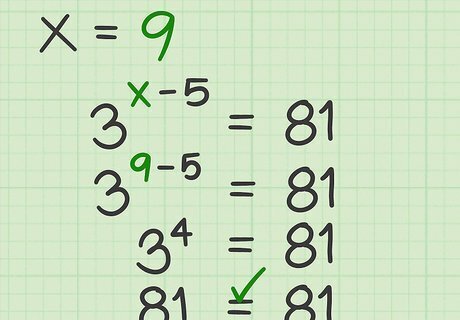
Check your work. You can see if your answer is correct by plugging the solution you found back into the original equation. After simplifying each expression, both sides of the equation should be equal. If they aren’t, you miscalculated and need to try again. For example, if you found that x = 9 {\displaystyle x=9} x=9, you would plug in 9 {\displaystyle 9} 9 for x {\displaystyle x} x in the original equation and simplify: 3 x − 5 = 81 {\displaystyle 3^{x-5}=81} 3^{{x-5}}=81 3 9 − 5 = 81 {\displaystyle 3^{9-5}=81} 3^{{9-5}}=81 3 4 = 81 {\displaystyle 3^{4}=81} 3^{{4}}=81 81 = 81 {\displaystyle 81=81} 81=81
Using Logs for Terms without the Same Base

Make sure that the exponential expression is isolated. One side of the equation should be the exponent, the other should be the whole number. If not, modify the equation so the exponent is alone on one side. For example, you need to isolate the expression 4 3 + x {\displaystyle 4^{3+x}} 4^{{3+x}} in the equation 4 3 + x − 8 = 17 {\displaystyle 4^{3+x}-8=17} 4^{{3+x}}-8=17 by adding 8 to both sides: 4 3 + x − 8 = 17 {\displaystyle 4^{3+x}-8=17} 4^{{3+x}}-8=17 4 3 + x − 8 + 8 = 17 + 8 {\displaystyle 4^{3+x}-8+8=17+8} 4^{{3+x}}-8+8=17+8 4 3 + x = 25 {\displaystyle 4^{3+x}=25} 4^{{3+x}}=25
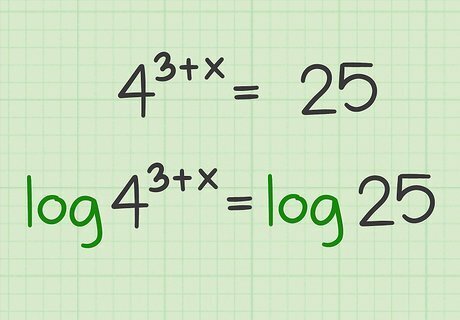
Rewrite the equation. Set up the equation so that you are taking the log of both sides. A log is the inverse of an exponent. You can find a base-10 log using most scientific calculators. For now, you are just rewriting the equation, indicating you are taking the log of each side. For example, if you take the base-10 log of both sides of 4 3 + x = 25 {\displaystyle 4^{3+x}=25} 4^{{3+x}}=25, you would rewrite the equation like this: log 4 3 + x = log 25 {\displaystyle {\text{log}}4^{3+x}={\text{log}}25} {\text{log}}4^{{3+x}}={\text{log}}25.
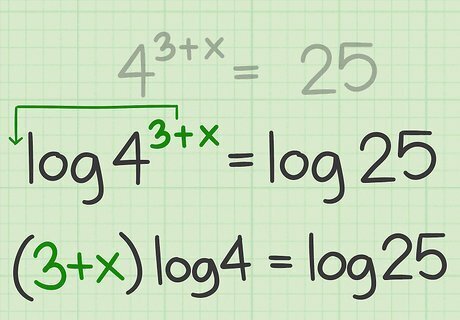
Rewrite the log of the exponent. Rewrite it using the rule log a r = r log a {\displaystyle {\text{log}}a^{r}=r{\text{log}}a} {\text{log}}a^{{r}}=r{\text{log}}a. Rewriting the exponential expression this way will allow you to simplify and solve the equation. Do not calculate the logs yet. For example, log 4 3 + x = log 25 {\displaystyle {\text{log}}4^{3+x}={\text{log}}25} {\text{log}}4^{{3+x}}={\text{log}}25 can be rewritten as ( 3 + x ) log 4 = log 25 {\displaystyle (3+x){\text{log}}4={\text{log}}25} (3+x){\text{log}}4={\text{log}}25
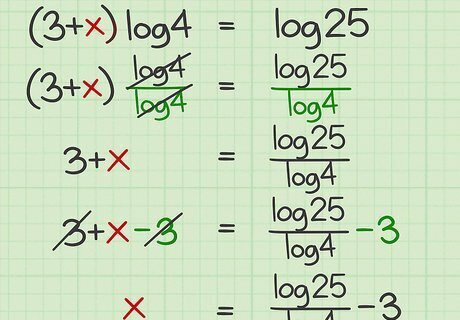
Isolate the variable. To solve, you need to rewrite the equation so that one side contains the variable, and the other side contains all of the numbers. You will need to divide each side of the equation by the log of the exponential expression. You will also need to add or subtract any constants to both sides, and perform any other necessary operations. For example, to isolate the x {\displaystyle x} x in ( 3 + x ) log 4 = log 25 {\displaystyle (3+x){\text{log}}4={\text{log}}25} (3+x){\text{log}}4={\text{log}}25, you first need to divide each side of the equation by log 4 {\displaystyle {\text{log}}4} {\text{log}}4, then subtract 3 from both sides: ( 3 + x ) log 4 = log 25 {\displaystyle (3+x){\text{log}}4={\text{log}}25} (3+x){\text{log}}4={\text{log}}25 ( 3 + x ) log 4 log 4 = log 25 log 4 {\displaystyle (3+x){\frac {{\text{log}}4}{{\text{log}}4}}={\frac {{\text{log}}25}{{\text{log}}4}}} (3+x){\frac {{\text{log}}4}{{\text{log}}4}}={\frac {{\text{log}}25}{{\text{log}}4}} 3 + x = log 25 log 4 {\displaystyle 3+x={\frac {{\text{log}}25}{{\text{log}}4}}} 3+x={\frac {{\text{log}}25}{{\text{log}}4}} 3 + x − 3 = log 25 log 4 − 3 {\displaystyle 3+x-3={\frac {{\text{log}}25}{{\text{log}}4}}-3} 3+x-3={\frac {{\text{log}}25}{{\text{log}}4}}-3 x = log 25 log 4 − 3 {\displaystyle x={\frac {{\text{log}}25}{{\text{log}}4}}-3} x={\frac {{\text{log}}25}{{\text{log}}4}}-3
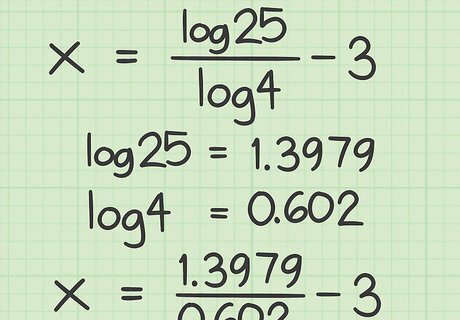
Find the logs in the equation. You can do this using a scientific calculator. Type the number you are finding the log of, then hit the LOG {\displaystyle {\text{LOG}}} {\text{LOG}} button. Rewrite the equation using these new values for the logs. For example, to find log 25 {\displaystyle {\text{log}}25} {\text{log}}25, hit 25 {\displaystyle 25} 25, then LOG {\displaystyle {\text{LOG}}} {\text{LOG}} on your calculator, to get about 1.3979. To find log 4 {\displaystyle {\text{log}}4} {\text{log}}4, hit 4 {\displaystyle 4} 4, then LOG {\displaystyle {\text{LOG}}} {\text{LOG}} on your calculator, to get about 0.602. You new equation will now be x = 1.3979 0.602 − 3 {\displaystyle x={\frac {1.3979}{0.602}}-3} x={\frac {1.3979}{0.602}}-3.
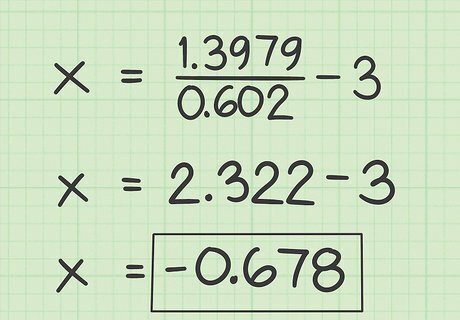
Complete the calculations. This will give you the value of the variable. Your answer will be approximate since you rounded when finding the logs. Remember to use the order of operations when making your calculations. For more instructions on how to calculate using the order of operations, read Evaluate an Expression Using PEMDAS. For example, in x = 1.3979 0.602 − 3 {\displaystyle x={\frac {1.3979}{0.602}}-3} x={\frac {1.3979}{0.602}}-3 you should divide first, then subtract: x = 1.3979 0.602 − 3 {\displaystyle x={\frac {1.3979}{0.602}}-3} x={\frac {1.3979}{0.602}}-3 x = 2.322 − 3 {\displaystyle x=2.322-3} x=2.322-3 x = − 0.678 {\displaystyle x=-0.678} x=-0.678.



















Comments
0 comment